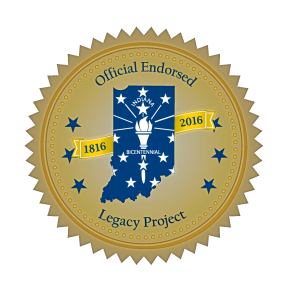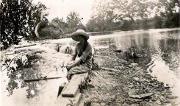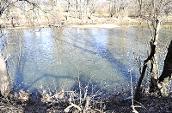IF THE RIVER COULD TALK
Throughout Indiana's Bicentennial year of 2016, Stephen T. Jackson, Madison County Historian, authored the book, If the River Could Talk. This series features people, places, and events that takes place in and around White River.
The series is an officially endorsed legacy project of the Indiana Bicentennial Commission.

The River would tell of about 12,000 years ago when the great Mastodon roamed the heavily forested land of Indiana and later the great Bison lived here.
The Ancient People lived along the river also, hunting and gathering and later growing crops and vegetables.
The numerous fords along White River were used by the wild animals, and Native Americans. Centuries later there were fur traders and hunters using the river to sustain themselves as well as for transportation.
If the River Could Talk, it would speak of the circus elephants and their frolic in the river.

The angle of the ford made crossing a risky task, especially during high water. The Whitinger Ford had a reputation of being a bad ford, even when the water level was low. A canoe was kept there for crossing when the river was high. It is believed that the Moss Island Dam(pictured) was built over the ford.
The river was somewhat swollen due to recent rains. Unfortunately, tragedy strikes as a group of boys enter the river to enjoy a swim.
When this bridge was built that took County Road 600 West over White River, usage of four Jackson Township fords ended.
Anderson's Town was one of five villages along White River. It was the largest and commanded a majestic presence situated upon a bluff 76 feet above the river. This location provided an unobstructed view necessary to protect the village from the threat of approaching enemies.
Regardless of rainfall amounts, a pleasurable canoe excursion was assured throughout the summer season. Patrons were free to explore the river as they pleased. The only rule was that you couldn't go beyond the park's boundary.
Camp Chesterfield Started in 1891
In the beginning, participants only had tents for housing. As the camp grew in popularity, accommodations and improvements were made.
The timber lodged in the bank and extending into White River is anchored to the bedrock with a bolt.
Laborers, mostly of Irish descent, hand dug the canal. Its dimensions were 6 feet deep and 28 feet wide. This was extremely hard and dangerous work.
There is no explanation why this canal spur exists. It connects to a section of the Central Canal eight miles west of downtown Anderson.
The Killbuck Mill was the last of the 19th century water-powered mills. It was built in 1860s. Photo--April 10, 1936.
Madison County Historical Society|15 West 11th Street, P. O. Box 696, Anderson, Indiana 46015-0696|(765)683-0052|madisonchs10@gmail.com

